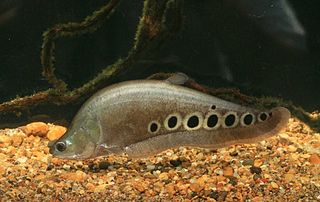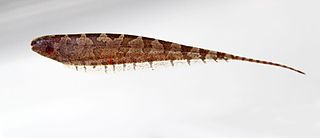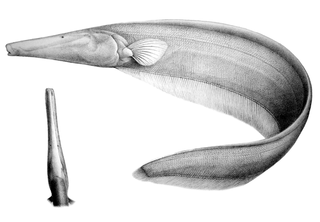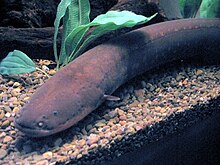
The Gymnotiformes are an order of teleost bony fishes commonly known as Neotropical knifefish or South American knifefish. They have long bodies and swim using undulations of their elongated anal fin. Found almost exclusively in fresh water, these mostly nocturnal fish are capable of producing electric fields to detect prey, for navigation, communication, and, in the case of the electric eel, attack and defense. A few species are familiar to the aquarium trade, such as the black ghost knifefish, the glass knifefish, and the banded knifefish.

Electrophorus electricus is the best-known species of electric eel. It is a South American electric fish. Until the discovery of two additional species in 2019, the genus was classified as the monotypic, with this species the only one in the genus. Despite the name, it is not an eel, but rather a knifefish. It is considered as a freshwater teleost which contains an electrogenic tissue that produces electric discharges.

The ghost knifefishes are a family, Apteronotidae, of ray-finned fishes in the order Gymnotiformes. These fish are native to Panama and South America. They inhabit a wide range of freshwater habitats, but more than half the species in the family are found deep in rivers where there is little or no light.
The Mastacembelidae are a family of fishes, known as the spiny eels. The Mastacembelids are part of the Order Synbranchiformes, the swamp eels, which are part of the Actinopterygii.

Electroreception and electrogenesis are the closely related biological abilities to perceive electrical stimuli and to generate electric fields. Both are used to locate prey; stronger electric discharges are used in a few groups of fishes to stun prey. The capabilities are found almost exclusively in aquatic or amphibious animals, since water is a much better conductor of electricity than air. In passive electrolocation, objects such as prey are detected by sensing the electric fields they create. In active electrolocation, fish generate a weak electric field and sense the different distortions of that field created by objects that conduct or resist electricity. Active electrolocation is practised by two groups of weakly electric fish, the Gymnotiformes (knifefishes) and the Mormyridae (elephantfishes), and by Gymnarchus niloticus, the African knifefish. An electric fish generates an electric field using an electric organ, modified from muscles in its tail. The field is called weak if it is only enough to detect prey, and strong if it is powerful enough to stun or kill. The field may be in brief pulses, as in the elephantfishes, or a continuous wave, as in the knifefishes. Some strongly electric fish, such as the electric eel, locate prey by generating a weak electric field, and then discharge their electric organs strongly to stun the prey; other strongly electric fish, such as the electric ray, electrolocate passively. The stargazers are unique in being strongly electric but not using electrolocation.
Pearlfish are marine fish in the ray-finned fish family Carapidae. Pearlfishes inhabit the tropical waters of the Atlantic, Indian, and Pacific Oceans at depths to 2,000 m (6,600 ft), along oceanic shelves and slopes. They are slender, elongated fish with no scales, translucent bodies, and dorsal fin rays which are shorter than their anal fin rays. Adults of most species live symbiotically inside various invertebrate hosts, and some live parasitically inside sea cucumbers. The larvae are free living.
Gymnotus is a genus of Neotropical freshwater fish in the family Gymnotidae found widely in South America, Central America and southern Mexico. The greatest species richness is found in the Amazon basin. They are sometimes referred to by the English name banded knifefish, although this typically is reserved for the most widespread species, G. carapo. Overall Gymnotus is the most widespread genus in the order Gymnotiformes.

Amphibious fish are fish that are able to leave water for extended periods of time. About 11 distantly related genera of fish are considered amphibious. This suggests that many fish genera independently evolved amphibious traits, a process known as convergent evolution. These fish use a range of terrestrial locomotory modes, such as lateral undulation, tripod-like walking, and jumping. Many of these locomotory modes incorporate multiple combinations of pectoral-, pelvic-, and tail-fin movement.

The family Notopteridae contains 10 species of osteoglossiform (bony-tongued) fishes, commonly known as featherbacks and knifefishes. These fishes live in freshwater or brackish environments in Africa and South and Southeast Asia.

Glass knifefishes are fishes in the family Sternopygidae in the order Gymnotiformes. Species are also known as rattail knifefishes.

The Hypopomidae are a family of fishes in the order Gymnotiformes known as the bluntnose knifefish. They may also be called grass or leaf knifefishes. These electric fish are not often eaten, of little commercial importance, rarely kept as aquarium fish, and poorly studied; however, species in this family may constitute a significant fraction of the biomass in the areas they inhabit.

In biology, the electric organ is an organ that an electric fish uses to create an electric field. Electric organs are derived from modified muscle or in some cases nerve tissue, and have evolved at least six times among the elasmobranchs and teleosts. These fish use their electric discharges for navigation, communication, mating, defence, and in strongly electric fish also for the incapacitation of prey.

The banded knifefish is a species of gymniform knifefish native to a wide range of freshwater habitats in South America. It is the most widespread species of Gymnotus, but it has frequently been confused with several relatives, including some found outside its range like the Central America G. maculosus. The English name "banded knifefish" is sometimes used for the entire genus Gymnotus instead of only the species G. carapo.
Anguilliformity is a morphological pattern in fishes, named for and typified by the eels. Anguilliform fish have a long, slender body, and travel by anguilliform motion. The caudal fin is often emphasized, with the other fins reduced, absent, or fused with the caudal fin. Anguilliformity has evolved independently in many groups, including among others:

Magosternarchus is a genus of weakly electric knifefish in the family Apteronotidae, containing two species. They are endemic to Brazil, occurring in large river channels in the Amazon River basin. Both species are unusual benthic predators that specialize in biting off the tails of other knifefishes, and are characterized by their greatly enlarged jaws and teeth. Recent systematic studies indicate that both species should be included in Sternarchella instead of being placed in their own genus.

Orthosternarchus tamandua, the tamandua knifefish, is a species of weakly electric knifefish in the family Apteronotidae, native to the deep river channels of the Amazon basin. This species is characterized by its whitish-pink color, long tubular snout, long dorsal appendage, and tiny, bilaterally asymmetrical eyes.

Rhamphichthys(Rhamphos = Greek for beak and Ichthys = Greek for fish) is a genus of fish that includes the South American sand knifefish. These fish are eel shaped with a distinct beak like snout which gave them their name. Like most other knifefish Rhamphichthys species have electrical organs that help them live in the murky waters of South America. Currently there are 10 recognized species of Rhamphichthys, although many changes have been made in their taxonomy since their original discovery.
Gymnotus choco, commonly known as the cuchillo, is an electric knifefish. G. choco is distinguished from its cogenerate species group by a color pattern possessing pale yellow bands oriented obliquely, wherein the interband margins are wavy or even irregular; one to three Y-shaped dark bands occur on its body's posterior section; and its pale bands do not extend above the fish's lateral line on its body's anterior two-thirds. G. choco is most similar to G. paraguensis from the Pantanal in Brazil and Paraguay. From the latter, it is distinguished by having a narrower mouth, a more cylindrical body, and a longer preanal distance.

The electric eels are a genus, Electrophorus, of neotropical freshwater fish from South America in the family Gymnotidae. They are known for their ability to stun their prey by generating electricity, delivering shocks at up to 860 volts. Their electrical capabilities were first studied in 1775, contributing to the invention in 1800 of the electric battery.
Carl Sachs was a German zoologist, known for his discovery of what is now called Sachs' organ in the electric eel.












